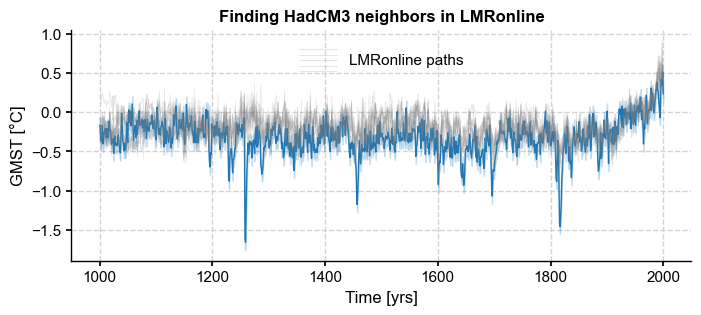[Figs. 6-8] Proximity Probability and Plume Distance#
This notebook explores a framework to assess the probability of observing a climate trace within an ensemble of trajectories, or observing one ensemble given another. The intended applications are to assess :
how distant/conflicting several reconstructions are from one another
how (in)compatible model simulations may be compared to a give reconstruction ensemble
Previous attempts using the likelihood (a density of proability) and parametric models have failed to produce robust and numerically sensible results. Here we go back to the drawing board and implement a new method.
The idea is to give oneself a tube of size \(\epsilon\) and shape given by the norm \(q\) (circular section for the 2-norm, diamond section for the 1 norm, “Philips head” for the infinity norm). One simply enumerates the number of ensemble trajectories that fit within \(\epsilon\) of the target. Given an ensemble \(X\) of trajectories, we proceed as follows: 1. compute the \(q\)-norm distance between a trace \(y\) and the nEns ensemble members. 2. graph the
distribution of distances \(d_q(y,X) = \lVert y-X \rVert_q\) to choose a sensible range of \(\epsilon\) parameters 3. Compute the proximity probability \(\mathbb{P}(d_q(y,X) \le \epsilon)\) as the proportion of ensemble members that fit within the tube for a given set of \(\epsilon\) parameters. 4. Graph this proportion as a function of \(\epsilon\).
We can use this distribution to define simple, robust statistics of distance.
The notebook reproduces Figs 6-9 of the paper.
[1]:
%load_ext autoreload
%autoreload 2
import pens
import pandas as pd
import numpy as np
import matplotlib.pyplot as plt
import seaborn as sns
plt.style.use('default')
pens.set_style('journal_nogrid')
PMIP3 past1000 runs vs LMRonline#
First, we focus on assessing these probabilities for the HadCM3 and CCSM4 past1000 GMST traces and their proximity to the LMRonline ensemble:
[2]:
ens_on = pens.EnsembleTS().load_nc('../data/gmt_MCruns_ensemble_full_LMRonline.nc', var='glob_mean', time_name='year')
ens_on.label = 'LMR online'
ens_on.time_unit = 'years'
ens_on.time_name='Time', # optional metadata: the name of the time axis
ens_on.value_name='GMST', # optional metadata: the name of the value axis
ens_on.value_unit='\N{DEGREE SIGN}C',
fig, ax = ens_on.plot_qs(color = 'tab:gray')
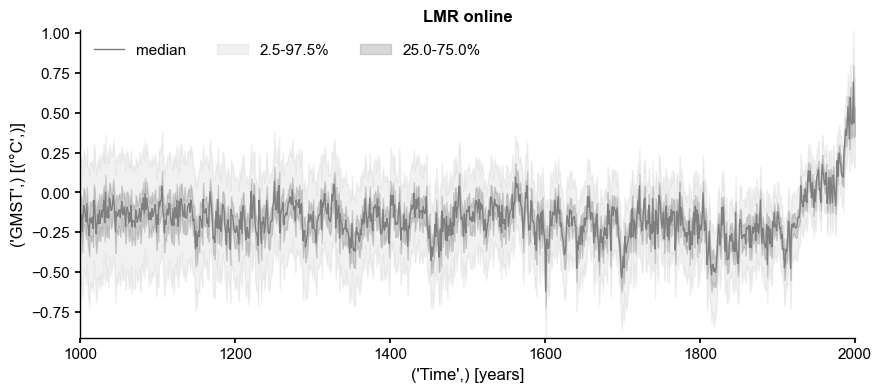
In such a representation, it is evident that, as the estimation becomes more uncertain back in time (due to data attrition in this case), the median shows less temporal variability. Conversely, while the ensemble converges around the median after 1500 CE, the median shows more temporal structure. The lack of such structure in the first millennium CE has been commented on (e.g. by Büntgen et al, 2020), with the claim assertion that it “lacks variability”, as opposed to e.g. transient simulations with General Circulation Models (GCMs), like that from HadCM3.
We first show that such an ensemble is in fact compatible with that simulation, in the sense that one can find an arbitrarily close trajectory within the ensemble that approximates the target.
PMIP3 simulations#
Let us load and plot the data first:
[3]:
df = pd.read_table('../data/PMIP3_GMST.txt')
# create a new pandas.DataFrame to store the processed data
dfn = df.copy()
# remove the data columns for CESM and GISS ensemble members
for i in range(10):
dfn = dfn.drop([f'CESM_member_{i+1}'], axis=1)
dfn = dfn.drop(['GISS-E2-R_r1i1p127.1'], axis=1)
dfn = dfn.drop(['GISS-E2-R_r1i1p127'], axis=1)
dfn = dfn.drop(['GISS-E2-R_r1i1p121'], axis=1)
# calculate the ensemble mean for CESM and GISS, and add the results into the table
dfn['CESM'] = df[[
'CESM_member_1',
'CESM_member_2',
'CESM_member_3',
'CESM_member_4',
'CESM_member_5',
'CESM_member_6',
'CESM_member_7',
'CESM_member_8',
'CESM_member_9',
'CESM_member_10',
]].mean(axis=1)
dfn['GISS'] = df[[
'GISS-E2-R_r1i1p127.1',
'GISS-E2-R_r1i1p127',
'GISS-E2-R_r1i1p121',
]].mean(axis=1)
# display the processed data
dfn
[3]:
| Year | bcc_csm1_1 | CCSM4 | FGOALS_gl | FGOALS_s2 | IPSL_CM5A_LR | MPI_ESM_P | CSIRO | HadCM3 | CESM | GISS | |
|---|---|---|---|---|---|---|---|---|---|---|---|
| 0 | 850 | -0.570693 | -0.431830 | NaN | -0.620995 | -0.475963 | -0.170230 | NaN | -0.620517 | 0.049553 | 0.127429 |
| 1 | 851 | -0.698903 | -0.411177 | NaN | -0.753160 | -0.742970 | -0.303124 | -0.398695 | -0.553043 | 0.193858 | 0.138796 |
| 2 | 852 | -0.575440 | -0.404802 | NaN | -0.743508 | -0.758939 | -0.422623 | -0.406343 | -0.560791 | 0.185033 | 0.098170 |
| 3 | 853 | -0.724757 | -0.552719 | NaN | -0.869331 | -0.746460 | -0.335177 | -0.353557 | -0.438949 | 0.120470 | -0.054552 |
| 4 | 854 | -0.724328 | -0.734938 | NaN | -0.826238 | -0.684093 | -0.650792 | -0.416140 | -0.812194 | -0.081349 | -0.407169 |
| ... | ... | ... | ... | ... | ... | ... | ... | ... | ... | ... | ... |
| 1161 | 2011 | 1.013544 | NaN | NaN | NaN | NaN | NaN | NaN | NaN | NaN | NaN |
| 1162 | 2012 | NaN | NaN | NaN | NaN | NaN | NaN | NaN | NaN | NaN | NaN |
| 1163 | 2013 | NaN | NaN | NaN | NaN | NaN | NaN | NaN | NaN | NaN | NaN |
| 1164 | 2014 | NaN | NaN | NaN | NaN | NaN | NaN | NaN | NaN | NaN | NaN |
| 1165 | 2015 | NaN | NaN | NaN | NaN | NaN | NaN | NaN | NaN | NaN | NaN |
1166 rows × 11 columns
[4]:
# store each pyleoclim.Series() object into a dictionary and plot
import pyleoclim as pyleo
ts_dict = {}
for name in dfn.columns[1:]:
ts_dict[name] = pyleo.Series(
time=dfn['Year'].values, # the time axis
value=dfn[name].values, # the value axis
label=name, # optional metadata: the nickname of the series
time_name='Time', # optional metadata: the name of the time axis
time_unit='yrs', # optional metadata: the unit of the time axis
value_name='GMST', # optional metadata: the name of the value axis
value_unit='\N{DEGREE SIGN}C', # optional metadata: the unit of the value axis
verbose = False,
)
ts_list = [v for k, v in ts_dict.items()] # a pythonic way to convert the pyleo.Series items in the dictionary to a list
ms_pmip = pyleo.MultipleSeries(ts_list)
fig, ax = ms_pmip.plot(lgd_kwargs={
'bbox_to_anchor': (1.25, 1), # move the legend to the right side
})
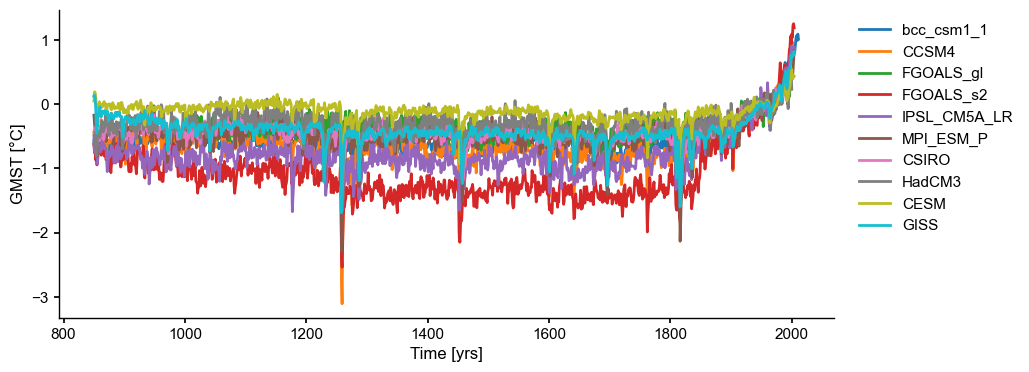
[5]:
common_time = [1000, 2000]
HadCM3 = ts_list[7].slice(common_time)
CCSM4 = ts_list[1].slice(common_time)
path_nearest = ens_on.sample_nearest(HadCM3.value, metric='MSE')
dist = path_nearest.distance # extract distance metric
fig, ax = path_nearest.plot(figsize=(8,4),
title='Closest LMR match (MSE = {:4.3f})'.format(dist),
color='k', label='Nearest LMR path', alpha=0.7,
)
HadCM3.plot(ax=ax, ylim=(-2.5, 1), alpha=0.7, linewidth=1)
ax.legend(loc='lower left', ncol=1)
ax.set_xlim(common_time)
[5]:
(1000.0, 2000.0)
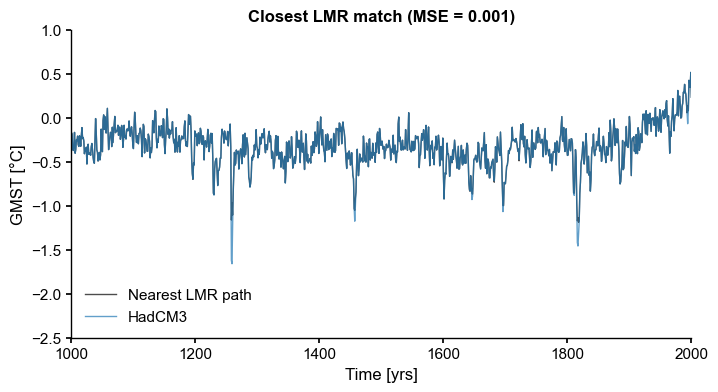
[6]:
ts_match = path_nearest.to_pyleo()
corr = ts_match.correlation(HadCM3)
print(corr)
Time axis values sorted in ascending order
Evaluating association on surrogate pairs: 100%|██████████| 1000/1000 [00:00<00:00, 2963.05it/s]
correlation p-value signif. (α: 0.05)
------------- --------- -------------------
0.991096 < 1e-6 True
We were indeed able to find a trajectory that highly correlates with the target (\(\hat{\rho} > 0.99\)). The question is: how likely is that trajectory under the ensemble’s distribution? How can we define a probability measure over this space, given the number of potential resamplings? For \(n=2001\) temporal samples and \(m=2000\) ensemble members, this number is \(n^m\), which is astronomical. Can a probability still be defined without resorting to brute force?
Pathwise Approach : proximity probability#
Let’s plot the HadCM3 and CCSM4 past1000 GMST traces and vs the density of the LMRonline ensemble:
[7]:
fig, ax = ens_on.line_density()
HadCM3.plot(alpha=0.7, linewidth=1, color='tab:blue',ax=ax)
CCSM4.plot(alpha=0.7, linewidth=1, color='tab:orange',ax=ax)
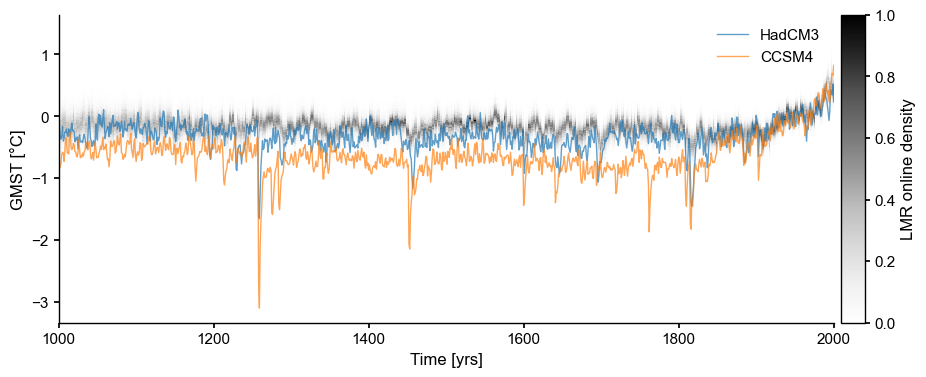
Visually, it is evident that HadCM3 is closer to LMRonline than CCSM4. Is this borne out by these metrics? Let us compute the distances between these traces and the ensemble, using different norms:
[8]:
models = ['HadCM3', 'CCSM4']
order = [1, 2, np.inf]
dist = np.zeros((len(models),len(order),ens_on.nEns))
for m, mdl in enumerate(models):
for r, ordr in enumerate(order):
dist[m, r, :] = ens_on.distance(y=eval(mdl).value,order=ordr)
[9]:
fig, axs = plt.subplots(1,3,figsize=(9,4))
axs = axs.flatten()
order_str = ['1','2',r'$\infty$']
for r, ordr in enumerate(order):
for m, mdl in enumerate(models):
sns.kdeplot(dist[m, r, :],ax=axs[r],label=mdl)
axs[r].set_xlabel('distance ($\epsilon$)')
axs[r].set_title(order_str[r]+'-norm',fontweight='bold')
axs[0].legend()
axs[1].set_ylabel(''); axs[2].set_ylabel('')
fig.tight_layout()
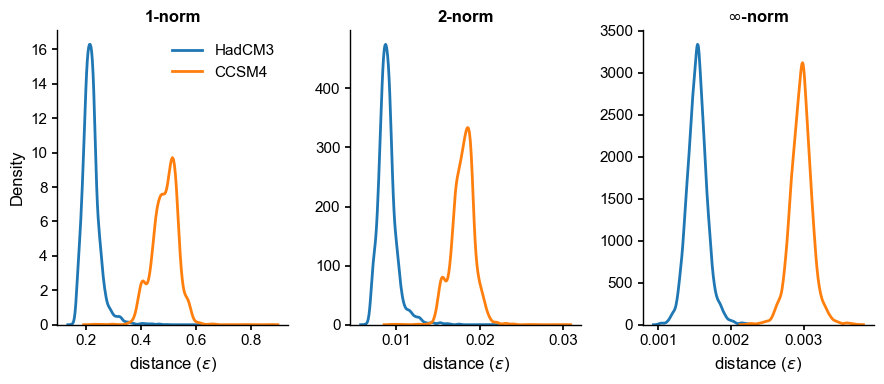
Indeed, HadCM3 is measurably closer. The results are qualitatively robust to the choice of norm, and surprisingly enough, nearly unchanged from \(q=1\) to \(q=2\). These results may now guide the choice of \(\epsilon\) to compute a probability, e.g. a Cumulative Distribution Function (CDF). For instance with the 1-norm:
[10]:
e = np.linspace(0,0.7,num=100)
prob = np.zeros((len(models),len(e)))
fig, ax = plt.subplots()
for m, mdl in enumerate(models):
prob[m, :] = ens_on.proximity_prob(y=eval(mdl).value, eps=e, order=1)
ax.plot(e,prob[m, :],label=mdl,marker='o')
ax.legend()
ax.axhline(y=0.5,color='k',ls=':')
ax.set_xlabel(r'Proximity threshold $\epsilon \, ({}^\circ \mathrm{C})$ ')
ax.set_ylabel(r'$\mathbb{P}(d_1(y,X) < \epsilon)$')
ax.set_title("Proximity probability with respect to LMRonline GMST", fontweight = 'bold')
[10]:
Text(0.5, 1.0, 'Proximity probability with respect to LMRonline GMST')
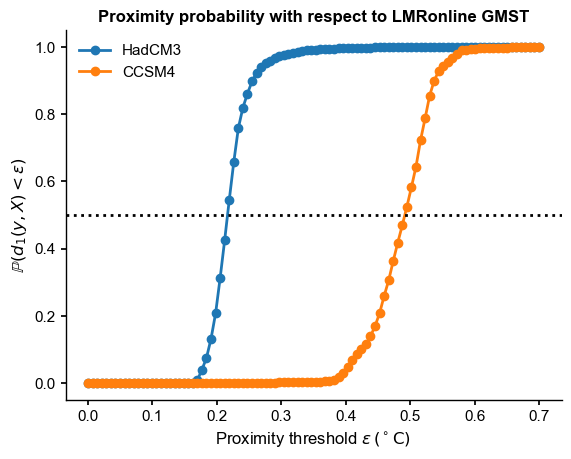
(results are nearly indistinguishable with the 2-norm).
Plume distance#
Definition#
From the CDFs obtained above, we would like to extract one metric that best summarizes the differences. In our tests, the shapes are very similar (abrupt climb for intermediate values of the proximity threshold), so a simple approach is to pick the difference between the values of epsilon for which these CDFs intersect \(P = 0.5\):
[11]:
# use this strategy for root finding: https://stackoverflow.com/a/46911822
def find_roots(x,y):
s = np.abs(np.diff(np.sign(y))).astype(bool)
return x[:-1][s] + np.diff(x)[s]/(np.abs(y[1:][s]/y[:-1][s])+1)
[12]:
eps_med = np.zeros((len(models)))
for m in range(2):
eps_med[m] = find_roots(e, prob[m, :]-0.5)[0]
print(eps_med[1] - eps_med[0])
0.2752498938114215
This metric suggests that HadCM3 is closer to LMRonline by about 0.27 degrees. (\(\epsilon\) has the same units as the variable of interest, in this case GMST). This is implemented as plume_distance() in pens:
[13]:
dist_HadCM3 = ens_on.plume_distance(y=eval('HadCM3').value, max_dist=0.7)
dist_CCSM4 = ens_on.plume_distance(y=eval('CCSM4').value, max_dist=0.7)
delta_eps = dist_CCSM4[0] - dist_HadCM3[0]
print(f'$\Delta_\epsilon = {delta_eps}$')
$\Delta_\epsilon = 0.2755582258356961$
[14]:
import matplotlib.patches as patches
fig, ax = plt.subplots()
yr = 0.55; xr = 0.35
for m, mdl in enumerate(models):
prob[m, :] = ens_on.proximity_prob(y=eval(mdl).value, eps=e, order=1)
ax.plot(e,prob[m, :],label=mdl,marker='o')
ax.legend()
ax.axhline(y=0.5,color='k',ls=':')
ax.text(x=xr-.09, y=yr,s=fr'$\Delta \epsilon_{{50}} = $ {delta_eps:.4f}')
pa = patches.FancyArrowPatch((0.21, .5), (0.49, .5), arrowstyle='<|-|>', mutation_scale=20)
ax.add_patch(pa)
ax.set_xlabel(r'Proximity threshold $\epsilon \, ({}^\circ \mathrm{C})$ ')
ax.set_ylabel(r'$\mathbb{P}(d_1(y,X) < \epsilon)$')
ax.set_title("Plume distance with respect to LMRonline GMST", fontweight = 'bold')
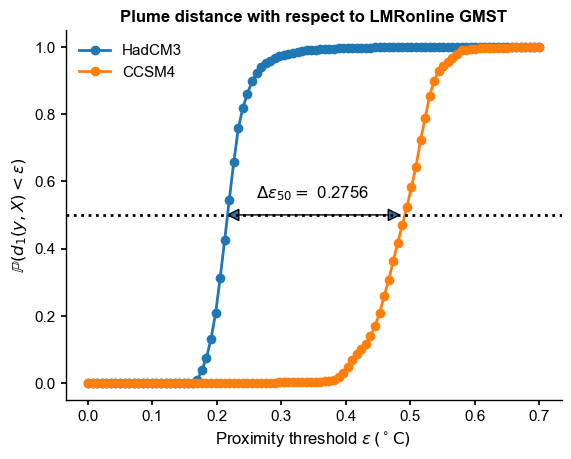
There would be many other possible metrics: - maximum horizontal difference between the 2 curves (similar to the Kolmogorov-Smyrnov statistic for CDFs) - area between the two curves (harder to compute, and units are less intuitive).
[15]:
imax = np.abs(np.diff(prob,axis=0)).argmax()
print(f'Max distance = {e[imax]}, prob = {prob[1,imax]}')
Max distance = 0.3606060606060606, prob = 0.004
This maximum distance falls at an extremely low probability, which seems arbitrary. The median seems a more justifiable choice, and a very easy one to implement. What are the properties of this newly defined metric?
Mathematical Properties of the Plume Distance#
Let us show that this verifies the conditions of a usual distance: - The distance from an object to itself is zero: it is trivially the case that if all the individual distances are 0, the distribution is a delta function centered at 0.
[16]:
ens1 = ens_on.subsample(400) # subsample for computational convenience
ens2 = ens_on.subsample(400)
d00 = ens1.plume_distance(y=ens1, max_dist=1)
print(d00)
objects are numerically identical
(0, 0.0)
More interesting is the case where thin subsets of the same ensemble are compared: the distance between two subsamples of the same plume will be small, but finite:
[17]:
ens1.plume_distance(y=ens2, max_dist=1)
Computing inter-ensemble distance: 100%|██████████| 400/400 [00:00<00:00, 1009.76it/s]
[17]:
(0.14142790802947053, 0.05058905937812187)
It tends to decrease as the ensemble size gets larger (better sampling of the full distribution):
[18]:
ens1 = ens_on.subsample(2000) # subsample for computational convenience
ens2 = ens_on.subsample(2000)
ens1.plume_distance(y=ens2, max_dist=1)
Computing inter-ensemble distance: 100%|██████████| 2000/2000 [00:10<00:00, 198.12it/s]
[18]:
(0.14160741602147853, 0.051939271665834175)
(Positivity) The distance between two distinct points is always positive: trivial, as the metric can only pick \(\epsilon\) values that are positive-definite.
(Symmetry) The distance from x to y is always the same as the distance from y to x
Let’s compute this two ways and compare the result:
[19]:
ens1 = ens_on.subsample(400) # subsample for computational convenience
ens2 = ens_on.subsample(400)
d21 = ens1.plume_distance(y=ens2, max_dist=1)
d12 = ens2.plume_distance(y=ens1, max_dist=1)
print(d21[0]-d12[0])
Computing inter-ensemble distance: 100%|██████████| 400/400 [00:00<00:00, 1014.00it/s]
Computing inter-ensemble distance: 100%|██████████| 400/400 [00:00<00:00, 1022.20it/s]
0.0
The triangle inequality holds \(d(x, z) \leq d(x, y) + d(y, z)\) (see Appendix)
Updated Fig 7#
[20]:
fig, axs = plt.subplots(1,2,figsize=(9,4))
axs = axs.flatten()
ym = 10
for m, mdl in enumerate(models):
sns.kdeplot(dist[m, 0, :],ax=axs[0],label=mdl)
axs[0].axvline(x=np.median(dist[m, 0, :]),color='silver',ls=':')
pa0 = patches.FancyArrowPatch((0.21, ym), (0.49, ym), arrowstyle='<|-|>',
mutation_scale=20, color='k')
axs[0].add_patch(pa0)
axs[0].text(x=0.34, y=ym+1,s=fr'$\Delta \epsilon_{{50}} = $ {delta_eps:.4f}')
axs[0].set_xlabel(r'Proximity threshold $\epsilon \, ({}^\circ \mathrm{C})$ ')
axs[0].set_ylabel('Density')
axs[0].set_title("a) Proximity density w.r.t LMRonline GMST", fontweight = 'bold')
axs[0].legend()
yr = 0.55; xr = 0.35
for m, mdl in enumerate(models):
prob[m, :] = ens_on.proximity_prob(y=eval(mdl).value, eps=e, order=1)
axs[1].plot(e,prob[m, :],label=mdl) # ,marker='o'
#axs[1].legend()
axs[1].axhline(y=0.5,color='silver',ls=':',zorder=0)
axs[1].text(x=xr-.11, y=yr,s=fr'$\Delta \epsilon_{{50}} = $ {delta_eps:.4f}')
pa1 = patches.FancyArrowPatch((0.21, .5), (0.49, .5), arrowstyle='<|-|>', mutation_scale=20)
axs[1].add_patch(pa1)
axs[1].set_xlabel(r'Proximity threshold $\epsilon \, ({}^\circ \mathrm{C})$ ')
axs[1].set_ylabel(r'$\mathbb{P}(d_1(y,X) < \epsilon)$')
axs[1].set_title("b) Proximity probability (CDF)", fontweight = 'bold')
fig.tight_layout()
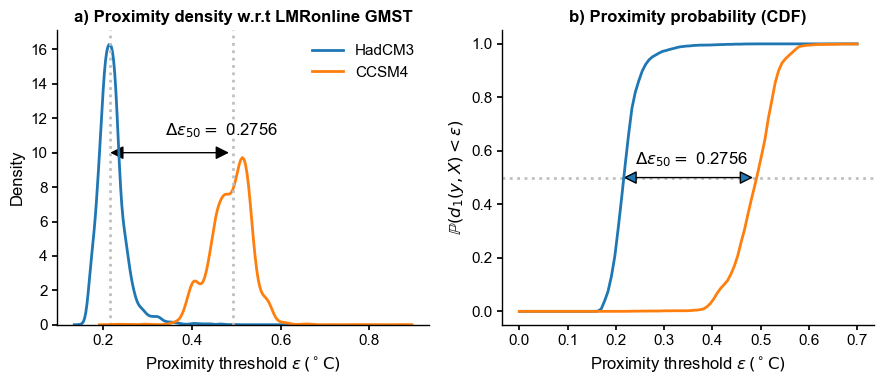
Plume-to-plume distance#
LMRoffline vs LMRonline#
Let’s see how compatible LMRonline and LMRv2.1 (offline) are by this metric:
[21]:
path = '../data/gmt_MCruns_ensemble_full_LMRv2.1.nc'
LMR = pens.EnsembleTS().load_nc(path, var='gmt')
ens_off = LMR.slice(common_time)
ens_off.label = 'LMR v2.1'
ens_off.value_name = 'GMST'
ens_off.value_unit = '\N{DEGREE SIGN}C'
[22]:
ens_o2000 = ens_on.subsample(nsamples=ens_off.nEns)
LMR_on_off_dist = ens_o2000.distance(ens_off)
sns.kdeplot(LMR_on_off_dist)
Computing inter-ensemble distance: 100%|██████████| 2000/2000 [00:13<00:00, 151.60it/s]
[22]:
<Axes: ylabel='Density'>
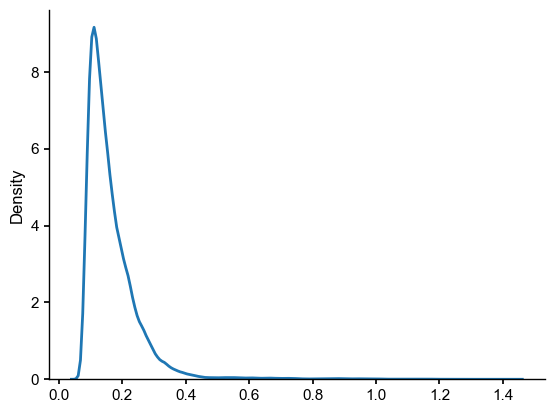
[23]:
LMR_on_off_plume_dist = ens_o2000.plume_distance(ens_off,dist=LMR_on_off_dist, max_dist=0.7)
print(LMR_on_off_plume_dist)
Computing inter-ensemble distance: 100%|██████████| 2000/2000 [00:13<00:00, 147.88it/s]
(0.14314926587664106, 0.08246367512627469)
How notable is this difference? A natural point of comparison would be the distribution of intra-ensemble distances: the distances (in whatever norm , here \(q=1\)) between any two pairs of ensemble members. For an ensemble of size \(N\), there are \(N(N-1)/2\) such pairs, so this can take a few seconds to compute):
[24]:
LMRon_intra_dist = ens_o2000.distance()
Computing intra-ensemble distance among possible pairs: 100%|██████████| 1999000/1999000 [00:05<00:00, 354623.08it/s]
[25]:
import scipy.stats as stats
hist = np.histogram(LMRon_intra_dist, bins=100)
hist_dist = stats.rv_histogram(hist)
hist_dist.cdf(0.2752)
[25]:
0.9621604593786395
[26]:
LMRoff_intra_dist = ens_off.distance()
Computing intra-ensemble distance among possible pairs: 100%|██████████| 1999000/1999000 [00:10<00:00, 197845.43it/s]
Now let’s plot these 3 quantities on the same graph (the plume distance is the dashed line):
[27]:
data = {'LMRonline': LMRon_intra_dist, 'LMR v2.1': LMRoff_intra_dist}
df = pd.DataFrame(data)
fig, ax = plt.subplots()
sns.kdeplot(df, fill=False, ax=ax, common_norm=False)
sns.kdeplot(LMR_on_off_dist,fill=True, ax=ax, common_norm=False, color='silver')
ax.axvline(x=LMR_on_off_plume_dist[0],color="black", linestyle="--",label='plume distance')
[27]:
<matplotlib.lines.Line2D at 0x3476015e0>
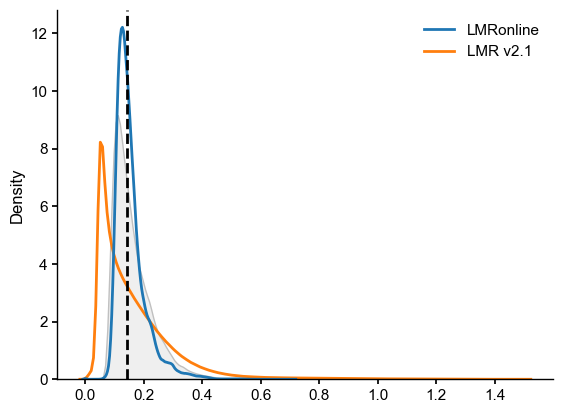
We see that the plume distance falls between the intra-ensemble distances. The LMRonline distances are clustured relatively tigthly around 0.2, and are entirely encompassed by the much wider range of distances found in LMR2.1. This would argue for the ensembles being considered compatible with each other. Let us make sure this is not an artifact of the lack of temporal varaibility in individual traces in the LMR 2.1 (offline) ensemble. Let’s resample it according to a power law, as done in
the resampling.ipynb notebook:
[28]:
ens_off_pl = ens_off.random_paths(model='power-law',param=0.92,p=2000)
100%|██████████| 2000/2000 [00:00<00:00, 2731.14it/s]
[29]:
LMRoff_pl_intra_dist = ens_off_pl.distance()
Computing intra-ensemble distance among possible pairs: 100%|██████████| 1999000/1999000 [00:08<00:00, 238234.22it/s]
[30]:
LMR_on_off_pl_dist = ens_o2000.distance(ens_off_pl)
LMR_on_off_pl_plume_dist = ens_o2000.plume_distance(ens_off_pl, dist=LMR_on_off_pl_dist)
print(LMR_on_off_pl_plume_dist)
Computing inter-ensemble distance: 100%|██████████| 2000/2000 [00:14<00:00, 138.14it/s]
Computing inter-ensemble distance: 100%|██████████| 2000/2000 [00:14<00:00, 139.98it/s]
(0.1632133968530639, 0.02783630604386758)
[31]:
data = {'LMRonline': LMRon_intra_dist, 'LMR v2.1': LMRoff_pl_intra_dist}
df_pl = pd.DataFrame(data)
fig, axs = plt.subplots(1,2,figsize=(10,4),sharey=True, sharex=True)
axs = axs.flatten()
sns.kdeplot(LMRon_intra_dist, fill=False, ax=axs[0], label='LMRonline',color='C0')
sns.kdeplot(LMRoff_intra_dist, fill=False, ax=axs[0], label='LMRv2.1',color='C1')
sns.kdeplot(LMR_on_off_dist, fill=True, ax=axs[0], label=r'on $\cap$ off',color='silver')
plume = LMR_on_off_plume_dist
axs[0].axvline(x=plume[0],color="silver", linestyle="--",
label=rf'$\Delta \epsilon_{{50}}=${plume[0]:3.2f} ({plume[1]:3.2f})')
axs[0].legend(loc = 'upper right')
axs[0].set_title('No resampling',weight='bold')
axs[0].set_xlim(0, 0.6)
axs[0].set_xlabel(r'Proximity threshold $\epsilon \, ({}^\circ \mathrm{C})$')
# with resampling
sns.kdeplot(LMRon_intra_dist, fill=False, ax=axs[1], common_norm=False, label='LMRonline',color='C0')
sns.kdeplot(LMRoff_pl_intra_dist, fill=False, ax=axs[1], common_norm=False, label='LMRv2.1 (resampled)',color='C1')
sns.kdeplot(LMR_on_off_pl_dist, fill=True, ax=axs[1], label=r'on $\cap$ off',color='silver')
plume = LMR_on_off_pl_plume_dist
axs[1].axvline(x=plume[0],color="silver", linestyle="--",
label=rf'$\Delta \epsilon_{{50}}=${plume[0]:3.2f} ({plume[1]:3.2f})')
axs[1].legend(loc = 'upper right')
axs[1].set_title('Power-law resampling',weight='bold')
axs[1].set_xlabel(r'Proximity threshold $\epsilon \, ({}^\circ \mathrm{C})$')
[31]:
Text(0.5, 0, 'Proximity threshold $\\epsilon \\, ({}^\\circ \\mathrm{C})$')
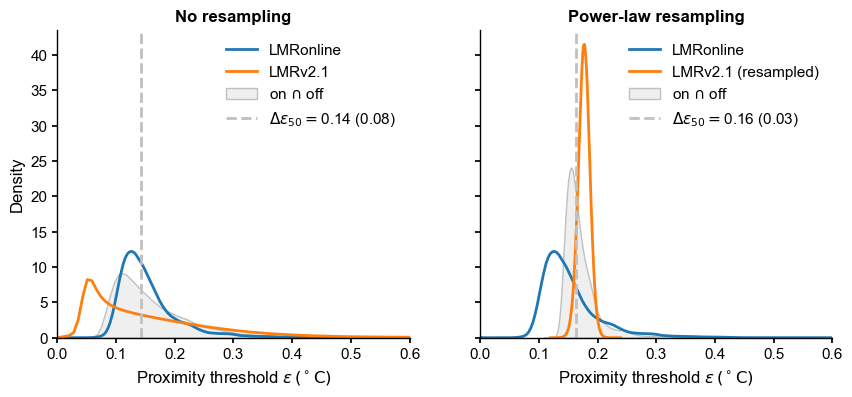
The blue distribution is common to both plots. We can see that resampling has a dramatic effect on the intra-ensemble distribution (orange), and on the plume distance (dashed line) as well. It is therefore important to pick a sensible temporal model when assessing such distances. Now the roles are reversed: LMR2.1 sits within LMRonline, and the plume distance appears typical of LMRonline intra-ensemble distances, coinciding nearly perfectly with the mode of its distribution. I would conclude that these two ensembles are mutually compatible.
Plot this on its own (for AGU 2023 talk)
[33]:
fig, ax = plt.subplots(figsize=(4,4))
sns.kdeplot(df['LMRonline'], fill=True, ax=ax, color='gray')
#sns.histplot(LMRon_intra_dist, ax=ax, stat="density", kde=True, color='Silver')
LMRon_q95 = np.quantile(LMRon_intra_dist,0.95)
ax.axvline(x=LMRon_q95,color="black", linestyle="--",linewidth=1,label=rf'$q_{{95}}=${LMRon_q95:.2f}')
ax.set_title('LMRonline intra-ensemble distances',fontweight='bold')
ax.legend()
ax.set_xlabel(r'$d_1 ({}^\circ$C)')
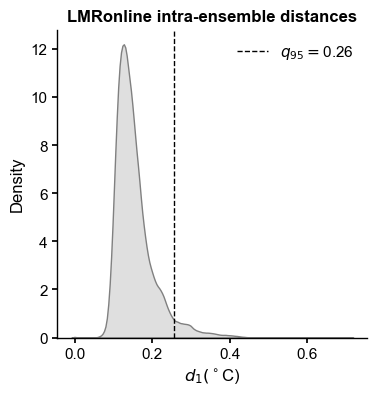
PMIP3 distances to LMRonline#
[34]:
ms_pmip.series_list[2]
{'label': 'FGOALS_gl'}
[34]:
None
Time [yrs]
1000.0 -0.159104
1001.0 -0.498624
1002.0 -0.424599
1003.0 -0.261818
1004.0 -0.381586
...
1994.0 0.292927
1995.0 0.341958
1996.0 0.121402
1997.0 0.229942
1998.0 0.345065
Name: GMST [°C], Length: 999, dtype: float64
[36]:
common = [1000, 1998] # FGOALS is ruining it for everyone else.
pmip3_plume_dist = np.empty((2,len(ts_list)))
for i, ts in enumerate(ms_pmip.series_list):
ts_lm = ts.slice(common)
pmip3_plume_dist[0,i] = ens_on.slice(common).plume_distance(y=ts_lm.value, max_dist=1.5)[0]
pmip3_plume_dist[1,i] = ens_off.slice(common).plume_distance(y=ts_lm.value, max_dist=1.5)[0]
print(f'Model {ts.label} has distance {pmip3_plume_dist[0,i]} to LMRonline')
print(f'Model {ts.label} has distance {pmip3_plume_dist[1,i]} to LMRv2.1')
Model bcc_csm1_1 has distance 0.41122165184578463 to LMRonline
Model bcc_csm1_1 has distance 0.43061836299386946 to LMRv2.1
Model CCSM4 has distance 0.4924558270224748 to LMRonline
Model CCSM4 has distance 0.5127193275900492 to LMRv2.1
Model FGOALS_gl has distance 0.23326211990115073 to LMRonline
Model FGOALS_gl has distance 0.23476287690846337 to LMRv2.1
Model FGOALS_s2 has distance 0.978092246110303 to LMRonline
Model FGOALS_s2 has distance 1.0033572883855542 to LMRv2.1
Model IPSL_CM5A_LR has distance 0.6358790945189334 to LMRonline
Model IPSL_CM5A_LR has distance 0.6572388754183671 to LMRv2.1
Model MPI_ESM_P has distance 0.3489545292443897 to LMRonline
Model MPI_ESM_P has distance 0.3653459146799062 to LMRv2.1
Model CSIRO has distance 0.290704050192928 to LMRonline
Model CSIRO has distance 0.30436399229309186 to LMRv2.1
Model HadCM3 has distance 0.21652265207791915 to LMRonline
Model HadCM3 has distance 0.21430357496984626 to LMRv2.1
Model CESM has distance 0.14846731161092247 to LMRonline
Model CESM has distance 0.12467358616019808 to LMRv2.1
Model GISS has distance 0.29227668421737935 to LMRonline
Model GISS has distance 0.3096662656988495 to LMRv2.1
Export to a LaTeX table for the paper:
[37]:
df_table = pd.DataFrame(pmip3_plume_dist,
index = ['LMRon','LMRoff'],
columns= dfn.columns[1:])
print(df_table.to_latex(formatters={"name": str.upper}, float_format="%.2f"))
\begin{tabular}{lrrrrrrrrrr}
\toprule
& bcc_csm1_1 & CCSM4 & FGOALS_gl & FGOALS_s2 & IPSL_CM5A_LR & MPI_ESM_P & CSIRO & HadCM3 & CESM & GISS \\
\midrule
LMRon & 0.41 & 0.49 & 0.23 & 0.98 & 0.64 & 0.35 & 0.29 & 0.22 & 0.15 & 0.29 \\
LMRoff & 0.43 & 0.51 & 0.23 & 1.00 & 0.66 & 0.37 & 0.30 & 0.21 & 0.12 & 0.31 \\
\bottomrule
\end{tabular}
Benchmarks:
[38]:
LMRon_q95 = np.quantile(LMRon_intra_dist,0.95)
print(f'{LMRon_q95:.2f}')
0.26
[39]:
LMRoff_q95 = np.quantile(LMRoff_pl_intra_dist,0.95)
print(f'{LMRoff_q95:.2f}')
0.19
Illustrate tube around HadCM3#
[40]:
pens.set_style('journal_grid')
fig_a, ax = plt.subplots(1,1,figsize = (8,3))
eps=0.1
xlabel, ylabel = HadCM3.make_labels()
ax.fill_between(HadCM3.time, HadCM3.value-eps, HadCM3.value+eps, color='tab:blue', alpha=0.2,
label=r'HadCM3$\pm \epsilon$')
HadCM3.plot(alpha=1, linewidth=1, color='tab:blue',linestyle='-',ax=ax)
ens_on.plot_traces(num_traces=10, alpha=0.2, ax=ax, color='gray',label='LMRonline paths')
ax.set_xlabel(xlabel)
ax.set_ylabel(ylabel)
ax.set_title('Finding HadCM3 neighbors in LMRonline',fontweight='bold')
[40]:
Text(0.5, 1.0, 'Finding HadCM3 neighbors in LMRonline')
